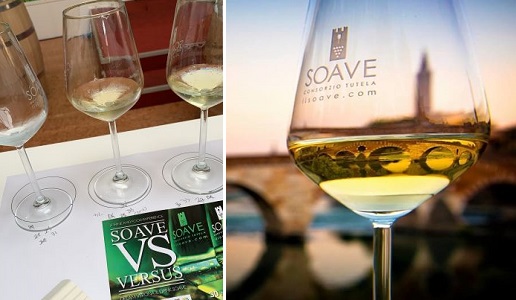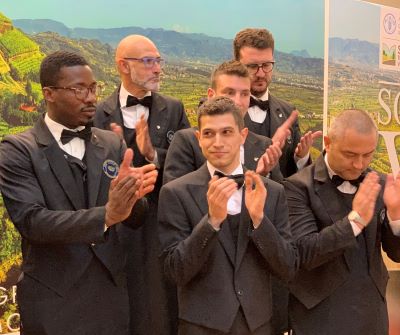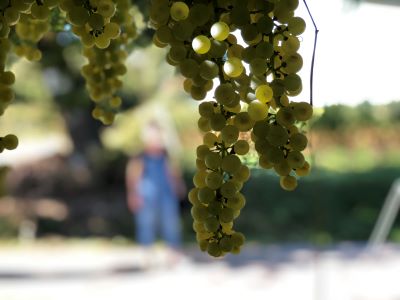Dream Verona and Drink Soave

This is the slogan of an annual event held in Palazzo della Gran Guardia and organized by the Consorzio Tutela Vino Soave.
A quick recap: Soave, a wine from the eastern area of the Verona province based Garganega on with a small addition of Trebbiano di Soave (although you can find 100% versions). The wine is DO classified and can come from the Classico zone, which is the historic and original one for producing this wine, or outside it. The soil is volcanic and there are some 6,000 hectares of vineyards with vines trained using the pergola (the traditional and for certain aspects highly recommended method) as well as Guyot system. The wines can be made into a dry, still wine or as a sparkling or sweet wine (Recioto). As of this year, this appellation, which already has an FAO recognition as an agricultural heritage site, was listed among the Additional Geographic Units (AGU).
As it does every year, Soave Versus took over the loggia of the Palazzo Gran Guardia, in Piazza Bra, from August 30 to September 2 for the 19th edition of this event. Although this event is well-known and time-tested, there is never a lack of novelties and, even if the location is the same, Soave Versus always comes up with something new every year.
This year’s edition was undoubtedly the first major occasion to begin to become familiar with the AGU wines. There are 33 mentions to learn and get to know up close and for me this is a way to intimately comprehend a territory and appreciate its many nuances.
An AGU mention is not limited to a vineyard but refers to an authentic subzone that can be identified by the composition of its soil, altitude, pitch of the land and vine-training system. They represent less than 40% of the vineyards and are found both in the Classico zone (for the most part) as well as the DOC one. For producers, this entails fermenting the grapes separately and imposing greater controls. The vineyards are all on hillsides and are: Castelcerino, Colombara, Froscà, Fittà, Foscarino, Volpare, Tremenalto, Carbonare, Tenda, Corte Durlo, Rugate, Croce, Costalunga, Coste, Zoppega, Menini, Monte Grande, Ca’ del Vento, Castellaro, Pressoni, Broia, Brognoligo, Costalta, Paradiso, Costeggiola, Casarsa, Monte di Colognola, Campagnola, Pigno, Duello, Sengialta and Ponsarà, Roncà – Monte Calvarina.
We at DoctorWine have great faith in this area and are, above all, big fans of zoning and so we welcomed this news. However, I must admit that I had to go a bit deeper and needed time to formulate a definitive idea about this novelty. I used this time to visit estates and vineyards in the DOC area. At the end of my exploring I could confirm what had up until then only been an intuition from reading the Consorzio’s official statement where there was a phrase that for me was a key to everything: enhancing the value of the appellation.
Enhancing the value by definition involves improving or adding to the value of something making it superior to what it was previously. So in my mind, the Consorzio and producers felt it necessary to step back from decisions made in 1968 (when the DOC was established) and to overhaul the zoning system. Recognizing values that were previously under-estimated or overlooked is both a reasonable and respectful act, obviously without discarding the term “Classico” to identify the wine’s historic origins in the area east of Verona.
Wandering about in the vineyards and tasting the wines from various zones allowed certain diverse characteristics to emerge. Aside from that “volcanic sensation”, which always emerges sometimes very strongly and sometimes just as a hint, the question arises: “why can the same wine seem different”. The answer is, in my opinion, the zone the grapes came from.
For sure, everyone has a right to their own opinion and I, personally, believe that winemaking in the Verona province in general (given its diversity with both hills and plains as well as rivers and lakes, dead volcanos, limy soil, morainic hills, sand, vineyards by the lakes and those at higher altitudes, the many local and international varieties of grapes, wineries producing millions of bottles and small producers) needs a zoning system and not taking this into consideration would represent a missed opportunity to define and intimately describe an appellation and its wines.
At this year’s Soave Versus, there were many truly interesting and instructive seminars and master classes. One in particular was the “l’Ora del Casaro” (Dairy Time) event that was organized in collaboration with Monte Veronese DOP (PDO) cheese consortium. Here, children and adults (especially adults) had a hands-on experience in making cheese, as well as tasting it, under the supervision of an expert.

While territory was a term much used during the last edition of Soave versus, there were other indicative ones as well a harvest forecastes. The 2019 harvest looks good. There was abundant rain during the season as well as sunshine in the middle of summer and finally there are now significant diurnal temperature variations which are fundamental for the phenolic maturity of the grapes. The Garganega, as well as the lesser varietals, this year appears to have bunches with smaller grapes with more space between then. Another important aspect is that this year the skins are thinner (due to the weather since spring) which means they are at greater risk of not only getting “burned” but rotting should there be abundant rainfall before harvest and they absorb too much water. The greatest threat to the 2019 harvest is undoubtedly the risk of hail. It can be devastating and growers know this and some have harvested their vineyards ahead of time in order to producer their wine. This is a risk that exists every year and is also an investment risk.
Just under 50 producers took part in the walk around tasting that also saw the participation of sponsors and food producers. There were many versions of Soave to get to know up close and personally. The many young winemakers present were interesting and all had very clear ideas of what they wanted to produce. The majority had inherited their family estates and are imposing their own imprint on them, never afraid to experiment day after day, season after season.
Good luck to all for the harvest and don’t forget to… Dream Verona and Drink Soave.

 Italiano
Italiano








